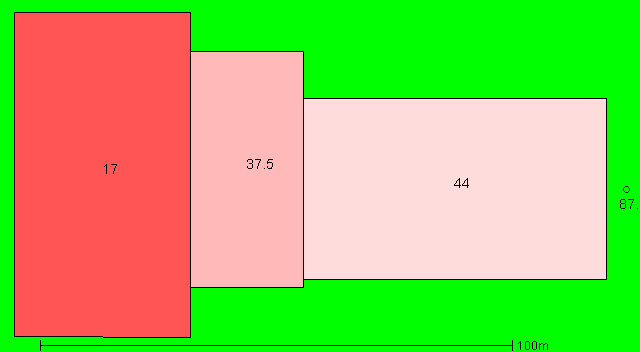
This page should be read in conjunction with How Plume Plotter Works. It provides more details specific to the Kwinana version of Plume Plotter.
Building measurements are taken from [1] and [2].
The image below shows the layout of the stack and building modelled. North is at the top; colours and numbers indicate the height of the buildings and the stack:

These are taken from [1] and [2]:
The following values are used for albedo, Bowen ratio and roughness length. None of these are specified in [1] or [2]:
The emission rates of pollutants are taken from [1] and [2]:
| Pollutant | Emission rate per second |
|---|---|
| Oxides of nitrogen | 8.4 g |
| Sulphur dioxide | 4.825 g |
| Carbon monoxide | 4.825 g |
| Particulates | 965 mg |
| Hydrogen chloride | 965 mg |
| Hydrogen flouride | 96.5 mg |
| TOC | 965 mg |
| Dioxins and furans | 9.65 ng |
| Cadmium and thallium | 4.825 mg |
| Mercury | 4.825 mg |
| Other metals | 48.25 mg |
The background levels of pollutants are taken from [1] and [2]:
| Pollutant | Background concentration per m3 |
|---|---|
| Oxides of nitrogen | 15 μg |
| Sulphur dioxide | 2.7 μg |
| Carbon monoxide | 815 μg |
| Particulates | 15 μg |
| Hydrogen chloride | N/A |
| Hydrogen flouride | N/A |
| TOC | N/A |
| Dioxins and furans | N/A |
| Cadmium and thallium | N/A |
| Mercury | N/A |
| Other metals | N/A |
Weather data is taken from METAR reports from a local airport: Jandakot.
Upper air data is the latest reported by the Perth International Airport upper air station.
1. Public Environmental Review - Kwinana Waste to Energy Project, Phoenix Energy. June 2014.